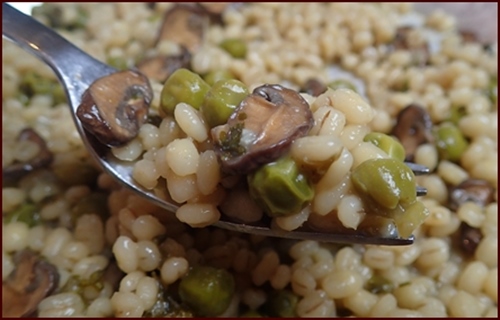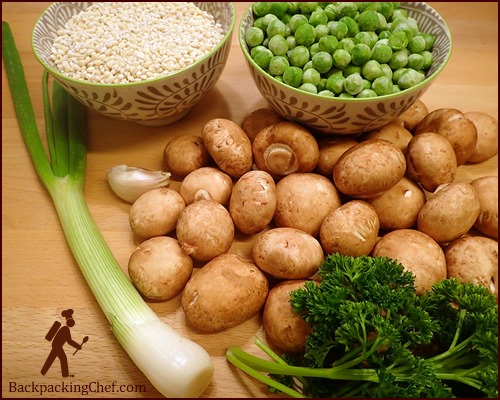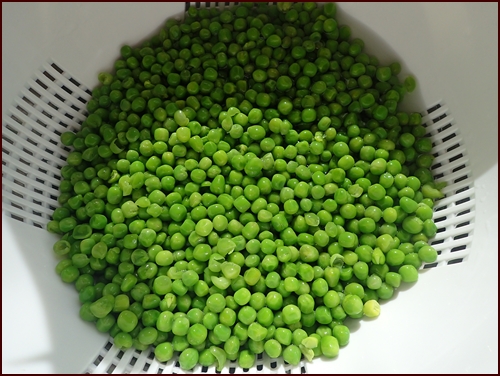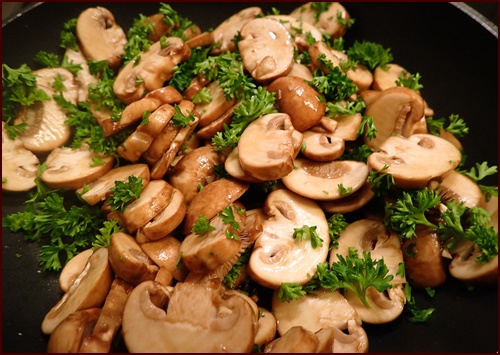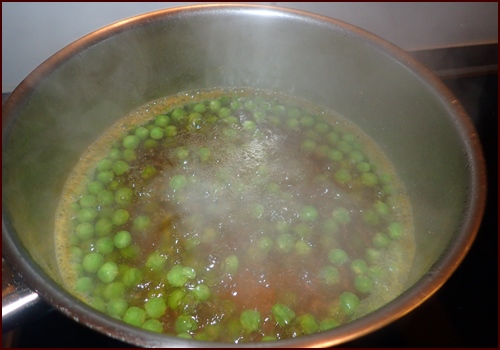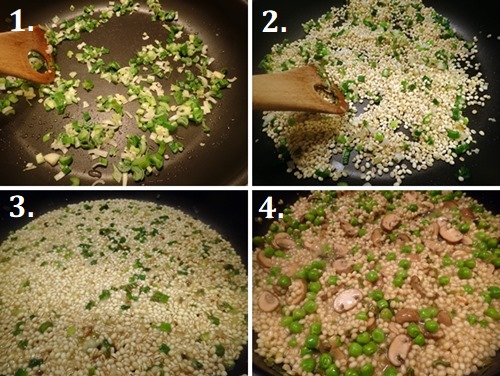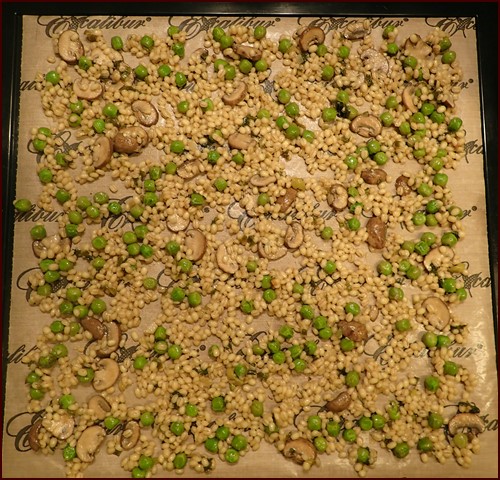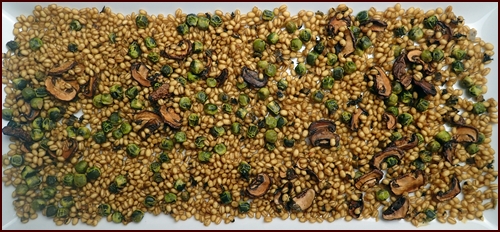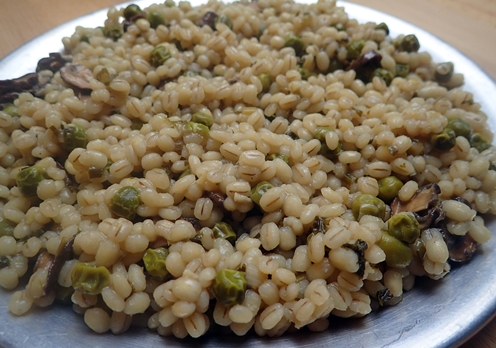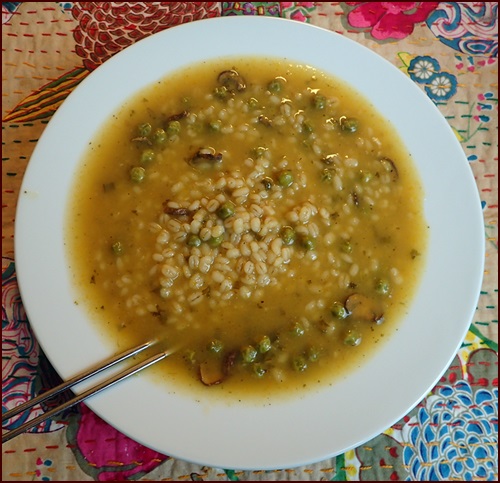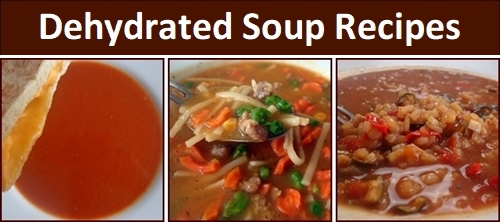| Back to Back Issues Page |
 |
|
February 2020 Trail Bytes: Barley Risotto with Peas & Mushrooms February 26, 2020 |
| Hello, Since last month’s Beef & Barley Stew recipe turned out so well, this month I present a savory vegetarian barley dish, cooked risotto-style. At the same time, I’ll revisit the question of how to deal with those hard to rehydrate peas.
Barley Risotto with Peas & MushroomsServings: 2Ingredients:
Another possible pre-drying method is blanching, followed by an ice water plunge. The theory is that the sudden change in temperature will burst the skins. For the experiment, I dropped a cup of frozen peas into a pot of boiling water. After three minutes, I drained off the water and plunged the peas into a bowl of ice water.
Photo above: Blanched peas after a dip in ice water. Some of the skins did break, but only a small percentage. For drying peas by themselves, I’ll stick with my usual method of steaming them for five minutes and lightly mushing them. When you steam or boil vegetables, you lose some nutrients in the drained off water. On the plus side, cooking stops enzymatic activity, so the peas should last longer in storage after drying. Also, the colors will be brighter, and cook-time on the trail will be shortened. For this month’s recipe, no nutrients went down the drain. I boiled a second batch of peas in vegetable broth, and retained the broth to cook the barley in. Step 1: Prepare the VegetablesSlice mushrooms, trim stems from parsley, chop green onion, press or mince garlic.
Step 2: Cook the MushroomsPlace mushrooms and parsley in a small pan. Add one tablespoon of Worcestershire Sauce, a half-tablespoon of balsamic vinegar, and a quarter-teaspoon of garlic powder. (Or use fresh garlic) Cook for three minutes and remove from heat.
Step 3: Cook the PeasBring four cups of vegetable broth to a boil. Ten grams of powdered vegetable bouillon was used to make the broth. Chicken broth may be substituted. Add peas and cook for three minutes. Strain peas over another large bowl, retaining the broth to cook the barley in. Set peas aside, and combine with the cooked mushrooms and salt/pepper to taste.
Step 4: Cook the Barley Risotto-Style1. In a large pan coated with a half-tablespoon of cooking oil, cook green onion and garlic for three minutes over medium-high heat.2. Add barley, stirring continuously for five minutes. 3. Add white wine and stir barley until the wine is absorbed. If you don’t want to use wine, you will hardly notice any difference if you just use vegetable broth. Continue adding vegetable broth, a half-cup at a time, allowing it to absorb into the barley each time. Once you’ve added all of the broth, the barley should have cooked to an al dente texture. 4. Add peas and mushrooms to cooked barley, simmer on low for five more minutes, then allow to cool. Enjoy! If serving for dinner, stir in a little butter and parmesan cheese to make it extra creamy. Leave out the butter and cheese if dehydrating. You can add parmesan cheese on the trail.
Photo above: One-half of recipe on Excalibur Dehydrator tray before drying. Step 5: Dehydrate the Barley RisottoDivide meal into two equal portions and spread on two dehydrator trays covered with non-stick sheets.Dehydrate for approximately eight hours @ 135° F (57° C)
Photo above: Dehydrated Barley Risotto with Peas & Mushrooms. This recipe yields slightly more than two cups (290 g) of dried barley risotto. Divide into two equal portions, approximately 145 grams each. This is a very filling serving size. On the Trail
Photo above: Rehydrated Barley Risotto with Peas & Mushrooms, cooked in Thermos. 1 Serving Pot Cooking: Combine one cup (145 g) dried barley risotto with 1¼ cups (236 ml) water in pot. Let soak five minutes, then light stove and bring to a boil. Simmer for one minute, then transfer pot to a pot cozy for fifteen to twenty minutes. Thermos Cooking: Place one cup (145 g) dried barley risotto in Thermos Food Jar and add 1½ cups (355 ml) boiled water. Note that you need 25% more water than with the pot method. Wait twenty minutes up to four hours. If waiting more than four hours, add a little more than 1½ cups water. Sprinkle parmesan cheese over the meal if desired.
Photo above: Soup, cooked in Thermos. Barley with Peas & Mushroom SoupPot Cooking: Combine a half-cup (72 g) of dried risotto barley and one tablespoon (10 grams) of powdered bouillon, with two cups of water in pot. Let soak five minutes, then light stove and bring to a boil. Simmer for one minute, then transfer pot to a pot cozy for fifteen to twenty minutes.Thermos Cooking: Combine a half-cup (73 g) of dried risotto barley and one tablespoon (10 grams) of powdered bouillon, with two cups of boiled water in thermos. Wait thirty minutes up to four hours. With either method, add a pinch of salt when serving if needed. How was it?Savory and pleasantly chewy. The peas were firm, not hard. The mushrooms were delicious with the added Worcestershire sauce and balsamic vinegar. Dominique ate the soup after it soaked for two-and-a-half hours in the thermos. She said it was very good, but last month’s beef and barley soup topped it.If the risotto-style method of cooking barley seems more hands-on than necessary, you could simply cook the barley in a pot, like rice, which is how I cooked it in last month’s recipe. I used three cups of vegetable broth with the pot method, and four cups of vegetable broth with the risotto method. That extra cup was needed due to evaporation. Either way, you’ll end up with a delicious meal. Back to those peas…One sure way to ensure that peas rehydrate well, even if you don’t poke or squish them, is to give them more time in boiled water. If cooking in a pot on the trail, try letting the meal sit ten or fifteen minutes longer than usual in a pot cozy after you remove it from the heat. Preparing a meal in advance using a thermos food jar works exceptionally well.New Article: Water Filters & PurifiersRead: Sawyer Water Filters put the Squeeze on PumpsI asked our BackpackingChef Facebook followers what kind of water filter systems they were using on the trail. Most readers use squeeze filters, some use pump filters, some use gravity systems, and a few use SteriPENs or chemical purifiers. The article covers information about what’s in the water, and options for protecting yourself. That’s it for this month. Thanks for reading along. I hope you give the new barley risotto recipe a try. Freundliche Grüsse,
Chef Glenn & Dominique P.S. If you have any questions or comments about this issue of Trail Bytes, please reply to this email or use this contact form. 

If you received this newsletter from a friend and would like to subscribe (it's free), subscribe here. Visit my BackpackingChef Facebook page for the lastest posts. Be sure to "follow" the page to continue seeing posts. |
| Back to Back Issues Page |
